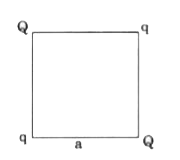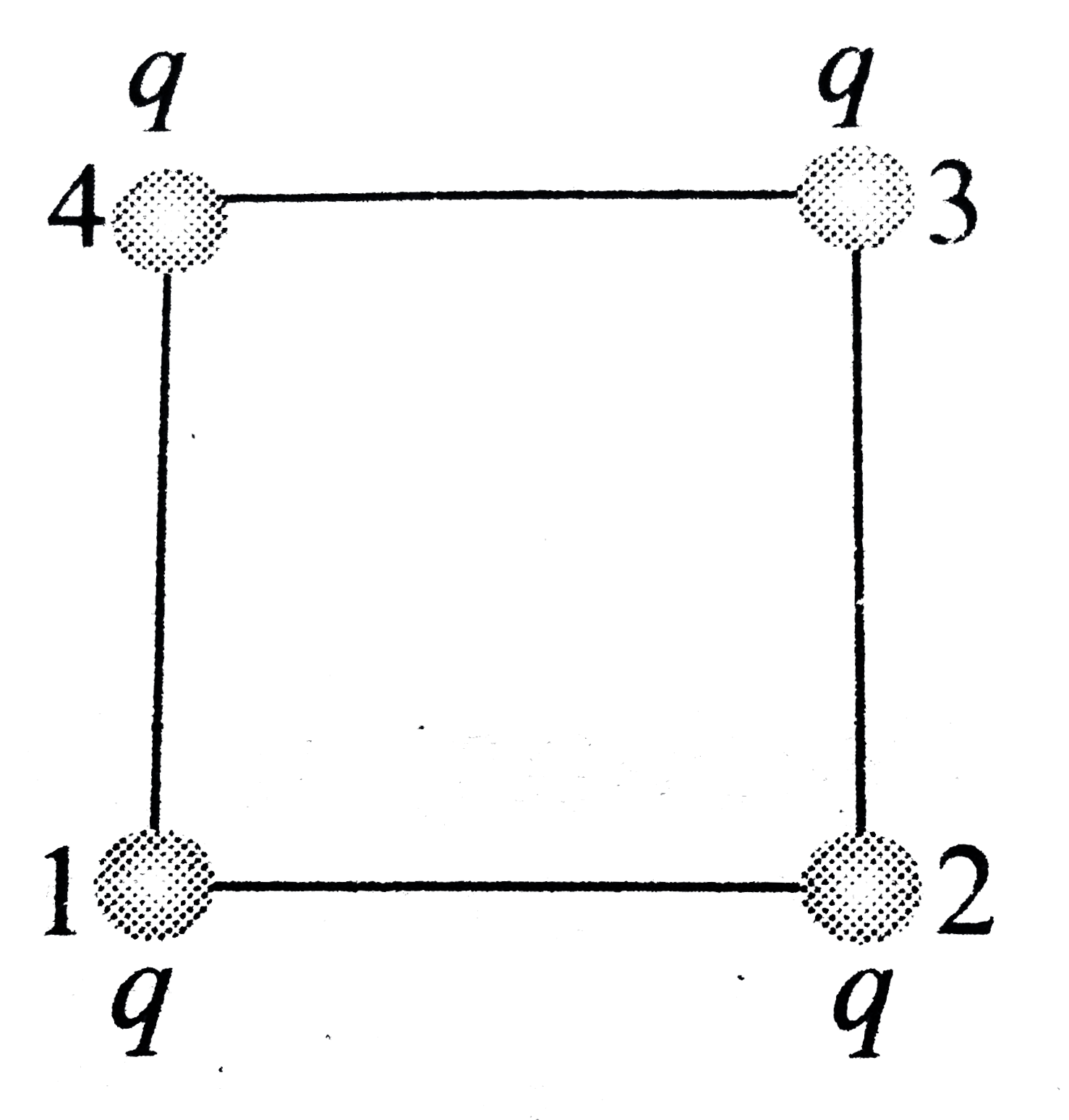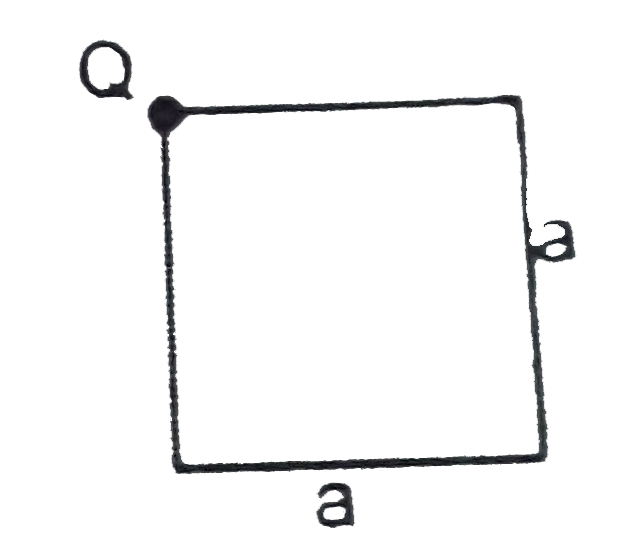Consider four equal charges (q, each) placed on the corners of a square with side a. Determine the magnitude and direction of the resultant force on the charge on lower right corner.
To solve the problem of determining the magnitude and direction of the resultant force on the charge at the lower right corner of a square configuration of four equal charges, we can follow these steps:
Step 1: Identify the Charges and Their Positions
We have four equal charges q placed at the corners of a square with side length a. Let's label the charges as follows:
- Charge 1 (q1) at the top left corner
- Charge 2 (q2) at the top right corner
- Charge 3 (q3) at the bottom left corner
- Charge 4 (q4) at the bottom right corner (the charge we are analyzing)
Step 2: Determine the Forces Acting on Charge 4
Charge 4 (q4) will experience repulsive forces from the other three charges:
- Force due to q1 (top left corner)
- Force due to q2 (top right corner)
- Force due to q3 (bottom left corner)
Step 3: Calculate the Magnitudes of the Forces
1. Force F14 (from q1 to q4):
- Distance between q1 and q4 is a.
- Magnitude:
F14=kq2a2
2. Force F24 (from q2 to q4):
- Distance between q2 and q4 is a.
- Magnitude:
F24=kq2a2
3. Force F34 (from q3 to q4):
- Distance between q3 and q4 is a.
- Magnitude:
F34=kq2a2
Step 4: Calculate the Resultant Forces
- Direction of Forces:
- F14 acts diagonally downwards to the right (45 degrees).
- F24 acts horizontally to the left.
- F34 acts vertically upwards.
Step 5: Resolve Forces into Components
1. Components of F14:
- F14x=F14cos(45∘)=F14√2
- F14y=F14sin(45∘)=F14√2
2. Components of F24:
- F24x=−F24 (to the left)
- F24y=0
3. Components of F34:
- F34x=0
- F34y=F34
Step 6: Sum the Components
- Total x-component:
Fnet,x=F14x−F24=F14√2−F24
- Total y-component:
Fnet,y=F34−F14y=F34−F14√2
Step 7: Calculate the Resultant Force Magnitude
Using the Pythagorean theorem:
Fnet=√(Fnet,x)2+(Fnet,y)2
Step 8: Determine the Direction of the Resultant Force
The direction can be found using:
tan(θ)=Fnet,yFnet,x
Final Result
The resultant force's magnitude and direction can be expressed as:
Fnet=kq2a2(1+2√2)
Direction: 45 degrees downward from the horizontal.
---
We have four equal charges q placed at the corners of a square with side length a. Let's label the charges as follows:
- Charge 1 (q1) at the top left corner
- Charge 2 (q2) at the top right corner
- Charge 3 (q3) at the bottom left corner
- Charge 4 (q4) at the bottom right corner (the charge we are analyzing)
Charge 4 (q4) will experience repulsive forces from the other three charges:
- Force due to q1 (top left corner)
- Force due to q2 (top right corner)
- Force due to q3 (bottom left corner)
1. Force F14 (from q1 to q4):
- Distance between q1 and q4 is a.
- Magnitude:
F14=kq2a2
- Distance between q2 and q4 is a.
- Magnitude:
F24=kq2a2
- Distance between q3 and q4 is a.
- Magnitude:
F34=kq2a2
- Direction of Forces:
- F14 acts diagonally downwards to the right (45 degrees).
- F24 acts horizontally to the left.
- F34 acts vertically upwards.
1. Components of F14:
- F14x=F14cos(45∘)=F14√2
- F14y=F14sin(45∘)=F14√2
- F24x=−F24 (to the left)
- F24y=0
- F34x=0
- F34y=F34
- Total x-component:
Fnet,x=F14x−F24=F14√2−F24
- Total y-component:
Fnet,y=F34−F14y=F34−F14√2
Using the Pythagorean theorem:
Fnet=√(Fnet,x)2+(Fnet,y)2
The direction can be found using:
tan(θ)=Fnet,yFnet,x
The resultant force's magnitude and direction can be expressed as:
Fnet=kq2a2(1+2√2)
Direction: 45 degrees downward from the horizontal.
Topper's Solved these Questions
- ELECTRIC CHARGES AND FIELDSBook:NARAYNAChapter:ELECTRIC CHARGES AND FIELDSExercise:EVALUATE YOURSELF-1
Explore 10 Videos
- ELECTRIC CHARGES AND FIELDSBook:NARAYNAChapter:ELECTRIC CHARGES AND FIELDSExercise:EVALUATE YOURSELF-2
Explore 9 Videos
- DUAL NATUREBook:NARAYNAChapter:DUAL NATUREExercise:LEVEL-II (H.W)
Explore 17 Videos
- ELECTRO MAGNETIC INDUCTIONBook:NARAYNAChapter:ELECTRO MAGNETIC INDUCTIONExercise:Level-II (H.W)
Explore 23 Videos
Similar Questions
Four point charges Q.q Q and q are placed at the corners of a square side 'a' as shown in the figures.

Find the resultant electric force on a charge Q,
View SolutionFour identical charges q are placed at the corners of a square of side a. Find the potential energy of one of the charges due to the remaining charges.
 .
.
View Solution
Knowledge Check
Equal charges q are placed at the three corners B, C, D of a square ABCD of side a. The potential at A is
A14πε0qaB3q4πε0Cq4πε0a[2+1√2]Dq4πε0a[1+√2]Five point charge (+q each) are placed at the five vertices of a regular hexagon of side 2a.what is the magnitude of the net electric field at the centre of the hexazon?
A14πε0qa2Bq2πε0a2C5q4πε0a2D5q2πε0a2
Equal charges of +4μC are placed at the three corners of an equilateral triangle of side 2m. Calculate the magnitude and direction of the force on one of the charges.
View SolutionFour point charges Q , q Q and q are placed at the corners of a square of side 'a' as shown in the Fig. Find the
resultant electric force on a charge Q
View SolutionA point charge Q is placed at the corner of a square of side a. Find the flux through the square.
View SolutionFour identical point charges q are placed at four corners of a square of side a. Find the potential energy of the charge system.
 .
.
View SolutionFour point charges of +1μc each are placed on the four corners of a square of side 1 m. Calculate the electric potential at the centre of the square.
View SolutionA point charge Q is placed at the corner of a square of side a, then find the flux through the square.

View Solution
